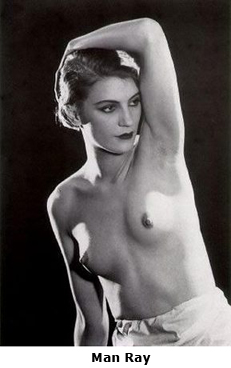|
The many aspects of Miller's peripatetic existence were amply surveyed recently in the Getty's exhibition, "Surrealist Muse: Lee Miller, Roland Penrose, and Man Ray," which included, along with a substantial number of her own photographs, the early pictures taken by her father, glamour shots from her modeling career in New York, and Surrealist drawings, paintings and photographs showing her influence on Man Ray, Picasso, and Penrose. Some of these are keenly personal and demonstrate the intensity of feeling she could inspire, as when Man Ray obsessively covered a pencil drawing of Miller's face with her name, scrawled over and over. What is most impressive, however, is Miller's steely composure in the face of death, where her sensitivity to texture and the dramatic play of light and shadow imbues even her photographs of some of the most grisly events of World War II with a Surrealist ambiance. Surprisingly, this artistic detachment does not detract, but rather contributes to the sense of outrage that inspired them ("I IMPLORE YOU TO BELIEVE THIS IS TRUE," Miller cabled to her editor, after being among the first to enter the Dachau concentration camp on its liberation), and the result is images that are at once theatrical, shockingly realistic, and compassionate. -Carol Diehl |
Lee Miller at the J. Paul Getty Museum, Los Angeles
Lee Miller at the J. Paul Getty Museum, Los Angeles
Art in America
March, 2004
 Lee Miller's (1907-1977) unusual life in photography began as a teenager in Poughkeepsie when she posed nude for her father's amateur efforts. Later in New York City, where she went to study theatrical design and lighting at the Art Students League, she stepped off a curb and was saved from being hit by an oncoming car by falling back into the arms of Conde Nast, who was so captivated by Miller's breezy but sophisticated beauty that he immediately signed her on to model for Vogue. Being immortalized by some of the top photographers of her time, however, was not enough to hold Miller's interest, and she followed her artistic leanings to Paris where she became Man Ray's studio assistant, model, and lover, influencing, and in turn being influenced by, the Surrealist milieu of which he was a part. Miller's verve and appetite for life was enormous (she saw no reason, for instance, why the Surrealists tenet of "free love" should not also apply to women, and disconcerted the men in her life by acting accordingly). Fueled by emotional restlessness, she was true to only to her passion for photography which, following a stint as a Cairo housewife, was most vividly realized in the photos she took as a war correspondent before settling down to motherhood and relative domesticity in England with Surrealist painter and writer Roland Penrose.
Lee Miller's (1907-1977) unusual life in photography began as a teenager in Poughkeepsie when she posed nude for her father's amateur efforts. Later in New York City, where she went to study theatrical design and lighting at the Art Students League, she stepped off a curb and was saved from being hit by an oncoming car by falling back into the arms of Conde Nast, who was so captivated by Miller's breezy but sophisticated beauty that he immediately signed her on to model for Vogue. Being immortalized by some of the top photographers of her time, however, was not enough to hold Miller's interest, and she followed her artistic leanings to Paris where she became Man Ray's studio assistant, model, and lover, influencing, and in turn being influenced by, the Surrealist milieu of which he was a part. Miller's verve and appetite for life was enormous (she saw no reason, for instance, why the Surrealists tenet of "free love" should not also apply to women, and disconcerted the men in her life by acting accordingly). Fueled by emotional restlessness, she was true to only to her passion for photography which, following a stint as a Cairo housewife, was most vividly realized in the photos she took as a war correspondent before settling down to motherhood and relative domesticity in England with Surrealist painter and writer Roland Penrose.